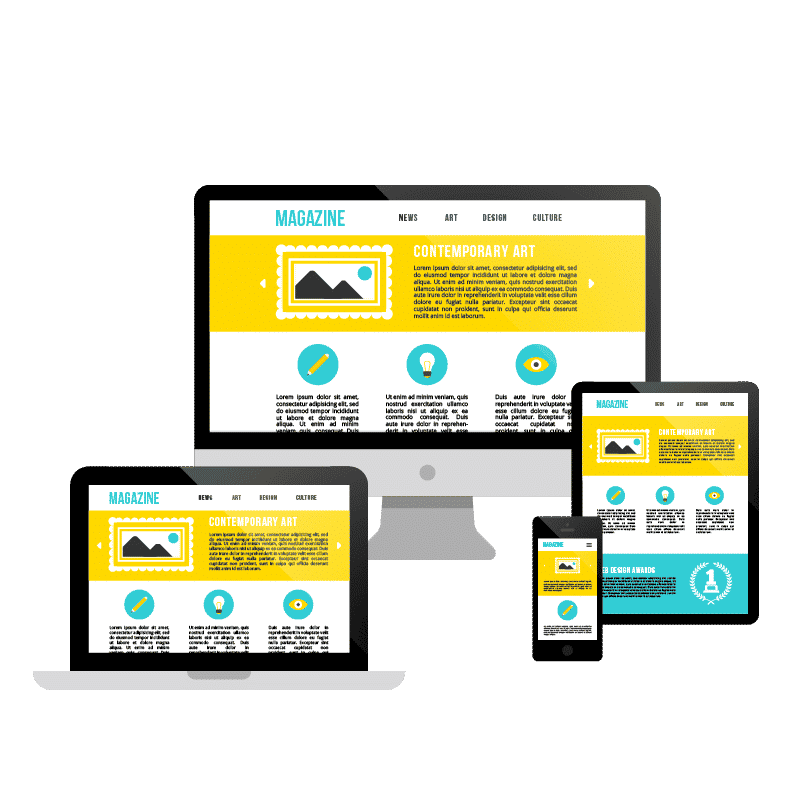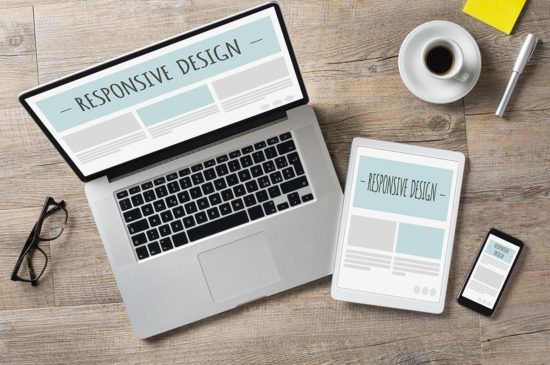
I. Introduction
Responsive design is more than just a fleeting design trend. It embodies an essential imperative, adapting to the diversity of devices used by Internet users. In the lines ahead, we'll take a deep dive into the complexity of responsive design, exploring its foundations, benefits, essential strategies for optimal implementation, its close relationship with SEO, eye-opening case studies, upcoming trends, as well as practical tips for meeting the inherent challenges. Let's start by defining this essential concept that underpins an uncompromising user experience.
II. Exploring Digital Diversity: Creating Inclusive Experiences

A. Definition of Adaptive Design: The Art of Adapting to All User Experiences
Imagine a seamless experience, where every interaction with a digital interface is like a fluid and harmonious dance, regardless of the rhythm or the device used. This is where the magic of adaptive design lies. It embodies much more than a simple response to different screen sizes. It's a complex symphony between user and interface, where each note is adjusted to create a perfect whole, no matter what stage it's played on.
To achieve this level of excellence, adaptive design is based on fundamental pillars. Structural flexibility is one, using dynamic grids and components that morph to perfectly align with each screen, whether it's a smartphone or a large desktop screen.
At its heart, responsive design puts content as the star, presenting it in a captivating way on any screen. While retaining its essence, the content resizes and adapts to maintain its visual impact and accessibility.
In this multi-device era, adopting a “Mobile-First” approach becomes imperative. This strategy involves prioritizing design for mobile devices and then seamlessly extending it for larger screens, providing a rich user experience regardless of the medium used.
Clever techniques, such as media queries, play the role of conductor, dynamically adjusting the visual rendering for each instrument, that is to say for each type of device. This guarantees a uniform and pleasant visual symphony for every digital music lover.
Finally, careful testing on a variety of devices maintains this digital harmony. They detect and correct any lag, thus guaranteeing an exceptional user experience, an unrivaled digital crescendo.
Responsive design is not just a visual solution, it is a melody that fuses aesthetics, functionality and accessibility. By adopting it, your interface becomes not only a visual work, but above all a functional symphony that resonates with all its audience, on any stage.
B. Evolution of Design: From Rigid to Adaptive, A Necessary Revolution
The web design landscape is evolving at breakneck speed, moving away from rigid designs to an adaptive approach, and this transformation goes far beyond just a trend: it's a compelling necessity. In the past, websites were designed for a single format, ignoring the growing diversity of screens and user needs.
This change is a response to an unavoidable reality: the multitude of connected devices. Today, a website must be able to offer a fluid and consistent experience, whether you browse from a smartphone, tablet or desktop computer. The key to this adaptation lies in moving from a fixed approach to a dynamic and adaptable design philosophy.
Responsive design is based on fundamental principles. It is about rethinking not only the visualization of content, but above all the way in which this content interacts with the user. Flexible grids, adaptable image sizes and optimized codes are at the heart of this transformation, allowing the interface to adjust seamlessly to each screen.
One of the preferred approaches is “Mobile-First”. This strategy involves designing for mobile devices first, then adapting that design for larger screens. This guarantees a high-performance user experience, regardless of the medium used.
The secret also lies in the use of technologies such as media queries. These intelligent tools allow dynamic adaptation of content and layout according to the characteristics of each device, ensuring visual and functional consistency.
Responsive design is not just a simple graphic reorganization. It’s a real transformation in the way interfaces interact with users. It’s a revolution that goes beyond simple dimensions to offer a harmonious and functional experience, regardless of the context or device.
By adopting this philosophy, web design is no longer a simple aesthetic, but a rich and borderless experience, guaranteeing unparalleled satisfaction and accessibility for every user, on every screen.
C. The Importance of Accessibility and Usability in a Multi-Device Era
Imagine a digital web where every individual, regardless of the device they use, feels welcomed and understood. In this multifaceted digital universe, accessibility and user-friendliness stand as guardians of this inclusiveness.
Accessibility is not limited to physical access, it is a gateway to inclusion. Skillful responsive design goes beyond simply making content available. She shapes it to be usable and understandable by everyone, whatever their way of interacting with the digital world.
Usability, on the other hand, represents the ability to create a tailor-made experience for each user. It is the prediction of needs, the simplification of journeys and the personalization of interactions. It is a conversation between the user and the interface, where each exchange is fluid, natural and predictable.
To guarantee maximum accessibility, standards such as WCAG are valuable allies. They provide clear guidelines for making web content more accessible to more people.
Conviviality, for its part, emerges from empathy and observation. Understanding users, their needs and expectations through testing, surveys and in-depth analysis allows us to shape interfaces that almost seem to guess each person's desires.
In short, adaptive design is not just about enhancing aesthetics. It unfolds like a welcoming digital cocoon, where each interaction becomes a tailor-made experience. It is an invitation to explore a universe without barriers, where each individual, regardless of their equipment, finds an authentic and unrestricted place.
III. Key Principles of Adaptive Design

A. Flexibility and Agility in Design: A Harmony Between Aesthetics and Functionality
The magic of responsive design lies in the art of merging aesthetics and functionality to create a web experience like no other. Here are some practical tips:
- Flexible Grids and Living Content: Imagine grids that dance to the rhythm of each screen, offering a captivating visual ballet, while content adapts with artistic flexibility.
- Mesmerizing Images, Instant Loading: Images and media that transform without losing their vibrancy, delivering a visual experience in a flash, captivating on any screen.
- Magical Color Palette, Bewitching Typo: Vibrant colors and captivating fonts, readable and in harmony, revealing a coherent and captivating visual experience.
- Intuitive Navigation, Personalized Adventure: Imagine navigation that instantly adapts to each user, offering a fluid, intuitive and personalized adventure.
- Marvelous Tests, Enchanted Feedback: Enchanted tests across a multitude of devices for a flawless experience, while user feedback transforms every interaction into perpetual magic.
- Lightning Optimization for Mesmerizing Loading: Stunning loading speed on all screens, delivering a responsive and captivating experience.
In short, this alchemy of responsive design delivers an enchanting, beautiful and functional web experience, capturing the imagination of every user, no matter the device.
B. Fluid Interfaces for Frictionless User Journeys
The magic of responsive design lies in creating interfaces that are both fluid and transparent. Here are the secrets to smooth travel on all screens:
- Instant Adaptability: Interfaces that dance to the rhythm of each screen, providing an uninterrupted experience, regardless of device changes.
- Intuitive Hierarchy: Fluid navigation, as instinctive as a walk, where each element naturally finds its place for exploration without pitfalls.
- Magical Transitions: Delicate animations and mesmerizing transitions, providing seamless immersion between each interaction.
- Lightning Speed: An ultra-fast performance, where each page is instantly revealed for an adventure without downtime.
- Elegant Touch: Touch interfaces as soft as velvet, enabling error-free navigation and intuitive interaction.
- Precise Analytics: Discreet magic operating behind the scenes, capturing user needs to shape a seamless, personalized experience.
By harmonizing these elements, adaptive design creates a fluid and captivating symphony, offering each user a magical, frictionless interaction, no matter the device used.
C. Media Queries and Other Innovative Techniques for Harmonious Adaptation
Media queries are the magicians of responsive design, but other sophisticated tricks sculpt a perfect fit for every screen. Here is a set of advanced practices for an enchanting adaptation:
- Magical and Responsive Design: Media queries shape the presentation, adjusting elements for a stunning experience on all screens, delivering a harmonious visual symphony.
- Sculpted and Vivid Images: Media queries shape images, reducing loading time without altering their beauty, creating a captivating visual experience.
- Cutting-Edge Typography: Adaptive fonts that dance gracefully across every screen, delivering smooth, elegant reading.
- Progressive Evolution: A magical progression, where the functional base evolves into a rich and dynamic experience for compatible devices.
- Flexbox and Grid for Perfect Staging: CSS tools that will orchestrate a perfect dance of elements, adapting effortlessly to all screen sizes.
- Multi-Device Testing, Revealing Magic: A check on a large number of devices, revealing and perfecting the details for a perfect fit.
Multi-Device Testing, Revealing Magic: A check on a large number of devices, revealing and perfecting the details for a perfect fit.
A. Sublimated User Experience: At the Heart of Adaptive Design

A. Sublimated User Experience: At the Heart of Adaptive Design
The adaptive design unfolds a unique spectacle for each user, offering a magical and captivating experience. Here are the keys to this enchanting experience:
- Immersive Personalization: Content tailored to the user’s context creates a personalized immersion, providing an experience like no other.
- Intuitive Interaction: Smooth, intuitive navigation that almost seems to guess the user's desires, providing an effortless swiping experience.
- Brilliant Inclusivity: A design accessible to everyone, providing a comfortable experience, regardless of how each user interacts with the web.
- Dazzling Multimedia Content: Responsive media that unfolds with fluid elegance, delivering optimal performance and visual brilliance with every load.
- Deep Connection: A precise analysis of user behavior makes it possible to weave a more connected experience, offering content in harmony with their expectations.
- Instant Feedback: Immediate feedback built in for continuous improvement, providing an ever-evolving experience.
This dazzling approach to responsive design ensures an experience that not only draws users in, but captivates them, engages them, and keeps them coming back to experience this renewed magic with each visit.
B. Wider Accessibility: To Reach All Audiences on All Screens
Expanded accessibility in responsive design opens doors to an enriching, inclusive and engaging experience for all. Here's how to make this vision a reality:
- Design for Everyone: Customize the interface to meet a variety of needs, offering vibrant contrast options, flexible fonts, and alternative content for a tailored experience.
- Intuitive Ease of Navigation: Clear directions, intuitive menus and intelligent search tools provide everyone with a hassle-free journey through the site.
- Harmony with Assistive Technologies: The interface is designed to harmonize with assistive tools, providing a consistent experience for all users.
- Adaptation on All Screens: A uniform and polished experience, from the phone screen to the desktop screen, for seamless accessibility.
- Inclusive Collaboration in Tests: The active contribution of users with disabilities guarantees an experience adapted to everyone, based on specific and real feedback.
- Training and Awareness: Educate teams from the earliest stages to integrate accessibility practices, thereby creating more inclusive and connected digital experiences from the genesis of projects.
By implementing these practices, responsive design not only opens doors to accessibility for all, but also creates captivating digital experiences, encompassing and engaging every user, thereby enriching connectivity and inclusion.
C. Business Benefits: Better Resonance, Increased Conversions
Responsive design is more than aesthetics: it drives business performance. Here is how this approach positively impacts economic results:
- Conversion-Driven User Experience: By providing a consistent and engaging experience across all devices, users are more likely to browse and convert, increasing the potential for sales and qualified leads.
- Reduced Abandonments: Adaptive design limits premature visitor departures, improving retention rates and extending their visit duration, thus promoting deeper interaction.
- Enhanced SEO Performance: Responsive sites benefit from better rankings on search engines, increasing visibility and appeal to potential new customers.
- Brand Consistency: Consistency of experience across devices solidifies brand recognition, establishing customer trust and loyalty.
- Improved Conversion Rates: Adaptability boosts engagement, promoting a more efficient transformation of visitors into customers or prospects.
- Comprehensive User Behavior Analysis: The use of sophisticated tools enables detailed analysis of user behavior patterns across various devices, providing valuable insights for continuous optimizations.
This business approach to responsive design, by acting as an enabler, optimizes performance, maximizing the impact on sales, conversions and user engagement.
V. In-Depth Strategies for Optimum Adaptive Design

A. Complete Understanding of User Expectations on Various Devices
Delving into the world of user expectations across a multitude of devices is the key to compelling adaptive design. Here's how to make this exploration captivating:
- Delving into the world of user expectations across a multitude of devices is the key to compelling adaptive design. Here's how to make this exploration captivating:
- Active User Sharing: Solicit users’ opinions and impressions of their experience, thereby transforming their feedback into catalysts for improvement.
- Representative User Panel: Invite diverse groups to test your platform, including representative profiles, to evaluate and refine the experience across different devices.
- Immersive Usability Studies: Conduct in-depth studies to assess the fluidity, accessibility and effectiveness of features, diving into the world of each device.
- Contextual Personalization: Adapt the experience to specific usage scenarios to provide seamless immersion in each usage context.
- Interactive Benchmarking: Compare and iterate performance for constant evolution, transforming this data into dynamic stories of continuous improvement.
This immersive approach, grounded in active user listening and interactive research, shapes an adaptive design that tells an engaging story, perfectly meeting user expectations on every device, delivering a fluid and captivating experience with every interaction.
B. A Mobile-First Approach and Progressive Evolution for a Robust Design
For a design that adapts harmoniously to all screens, merge the best of two worlds:
- Mobile-First, Experience-First: Start by thinking “mobile” to deliver an exceptional, agile and efficient experience, which then extends naturally to larger screens. This is the assurance of a solid foundation for an optimal user experience.
- Continuous Evolution, Constant Improvements: Take an iterative approach to constantly refine the design. It is by listening to user feedback and adjusting in real time that the design evolves to adapt to their changing needs.
- Modular and Flexible Architecture: Build an adaptable architecture using modular elements. This ensures a consistent and flexible experience across all devices, without compromising on quality.
- Performance Without Compromise: Obsess about loading speed. Optimize the user experience by minimizing loading times, providing a fast and seamless experience.
- Active Testing, Proactive Improvements: Integrate regular testing and respond to user feedback proactively, turning every interaction into an opportunity for continuous improvement.
- Contextual Adaptability: Anticipate the various contexts in which devices are used to deliver a tailored and engaging experience at every touchpoint.
This dynamic and proactive approach ensures a design that adapts naturally, providing an engaging, fluid and consistent user experience across devices.
C. Relevant Use of Development Frameworks and Innovative Tools
Mastery of development frameworks and the use of innovative tools are essential assets for flawless adaptive design. Here's how to enrich this approach to captivate more:
- Create with the Best Tools: Opt for frameworks like Bootstrap or Tailwind CSS for unrivaled adaptability, bringing to life intuitive, dynamic designs ready to conquer every screen.
- Journey Through Everyone's Eyes: Explore how your creation will look on all possible browsers and devices, ensuring a smooth experience for everyone, thanks to simple and efficient cross-platform testing.
- Collaborate in Harmony: Immerse yourself in visual collaboration tools like Figma, Adobe XD or Sketch, transforming design into a dynamic co-creation experience.
- Responsive Technology, Dynamic Experience: Integrate JavaScript frameworks like React and Vue.js for captivating interactions, delivering smooth navigation and unparalleled responsiveness.
- Stunning Performance: Optimize loading speed, accelerating each user's journey with analytics tools like Google Lighthouse, providing an unparalleled fluid experience.
- Test and Save the Hassle: Simplify testing and ensure a consistent experience across all screens with automation tools, turning every test into an assurance of perfection.
By integrating this palette of tools and strategies, you shape a user experience that is captivating, fluid and perfectly adapted to each screen, thus elevating your creation to the pinnacle of adaptability.
D. Rigorous Testing and Iterative Optimizations: Co-Creation with Users
Refining adaptive design requires a collaborative and iterative approach with users. Here's how to take this approach to the next level:
- User Testing: Organize testing sessions involving target users to directly observe their interactions, understand their needs and identify areas for improvement.
- Active Feedback: Encourage continuous feedback through surveys, direct feedback channels and feedback tracking tools, allowing detailed opinions and preferences to be captured.
- Behavior Analysis: Use in-depth analysis tools to understand user habits across various devices, enabling precise and in-depth adaptation.
- Rapid Iterations: Quickly integrate user feedback for responsive adjustments, ensuring continuous improvement and a refined user experience.
- Performance Testing: Test site responsiveness and performance across a diverse range of devices, ensuring an optimal experience even under extreme usage conditions.
- Experience Priority: Focus on improvements that directly impact the user experience, based on feedback received, ensuring consistency and increased satisfaction.
This immersive and iterative approach with users ensures a refined adaptive design, delivering an exceptional and constantly evolving user experience.
VI. The Close Alliance between SEO and Responsive Design
A. Mobile-First Indexing and Its Influence on SEO
Immerse yourself in the captivating world of “Mobile-First” indexing, the magic key to propel your site to the top of SEO! Here's how to magnify your online presence:
- Irresistible Mobile Experience: Envelop your visitors in a fluid and captivating mobile experience thanks to an adaptive design of unparalleled beauty, arousing the admiration of search engines.
- Dazzling Content for Mobile: Weave content for your mobile visitors that is both brief and deep, delivering instant resonance and a wealth of information to illuminate their searches.
- Blazing Speed: Make your site shine with lightning fast loading speed on mobile, a spectacle-worthy performance, to instantly capture the attention of your online viewers.
- Voice Harmony: Harmonize your content with voice searches by infusing it with a touch of naturalness and friendliness, thus attracting the verbal queries of your mobile audience.
- Test the Mobile Magic: Use Google's magic wand to assess your site's mobile-friendliness, unlocking the secrets to a dazzling presence on small screens.
By adopting these enchantments, you unleash the power of “Mobile-First” indexing, propelling your site to SEO heights and providing a dazzling experience for your mobile visitors.
B. Essential SEO Strategies for Responsive Design: Meta Tags, Loading Speed, etc.
Immerse yourself in the bewitching world of SEO strategies, the magic keys to enhancing your responsive design. Here are some spells to master to enchant your online presence:
- Eloquent Meta Tags: Adorn your Meta tags with magical formulas, inviting the curious to explore the treasures of your site, like a book with a thousand secrets.
- Eloquent Meta Tags: Adorn your Meta tags with magical formulas, inviting the curious to explore the treasures of your site, like a book with a thousand secrets.
- Mesmerizing Architecture: Weave a site structure as clear as a treasure map, guiding search engines to the hidden riches of your content.
- Enchanting Content: Infuse your content with magical keywords, captivating stories and bewitching knowledge, delivering a spellbinding experience to every visitor.
- Bewitching Accessibility: Bewitch your site so that it warmly welcomes all visitors, creating a universal spell across all screens.
By mastering these SEO enchantments, your responsive design radiates magic, offering a bewitching experience and dazzling visibility in the digital ocean.
C. The Impact on Engagement Metrics and SEO Performance
Dive into the mesmerizing world where responsive design shapes the destiny of your engagement metrics and SEO performance, revealing the keystone for stunning online visibility:
- Intensified Engagement: Responsive design captivates visitors, taking them on a seamless journey through your site, extending their visits and inviting them to explore every corner.
- SEO Hot: Responsive design transforms the SEO game. Your site becomes a beacon for search engines, raising its visibility and relevance in results.
- Brilliant Shine: With fine-tuned SEO performance, your site sparkles among the digital stars, attracting the attention and admiration of visitors looking for an exceptional experience.
- Sublime Conversion: Captivated visitors and optimized SEO turn into dazzling conversions, propelling your site to unparalleled commercial heights.
This fusion of responsive design and SEO transforms your site into a captivating experience, attracting, engaging and transforming each visitor into a loyal admirer.
VII. Future Trends in Responsive Design

A. Technological Advances Conducive to Adaptability: Artificial Intelligence, Augmented Reality, etc.
Immerse yourself in the fascinating world of upcoming trends, where artificial intelligence and augmented reality are redefining the adaptability of interfaces:
- Artificial Intelligence (AI) for Adaptability: Advanced AI systems will anticipate user needs, personalizing interfaces to deliver tailored experiences.
- Revolutionary Augmented Reality: Augmented reality will introduce immersive interactions, allowing users to interact with interfaces adapted to their physical environment.
- Conversational Interfaces: Advances in AI will enable more natural interactions, with interfaces adapting to fluid conversations, such as intelligent voice assistants.
- Contextual Adaptability: Interfaces will adapt in real time to user habits and preferences, providing more relevant experiences.
- Predictive and Personalized Analysis: Technological advances will enable predictive analysis to adjust interfaces based on anticipated user behaviors.
Predictive and Personalized Analysis: Technological advances will enable predictive analysis to adjust interfaces based on anticipated user behaviors.
B. Forecasts on the Evolution of User Interfaces for Multiple Devices
Discover the prospects for a spectacular evolution of user interfaces to adapt to a growing multitude of devices:
- Limitless Diversity: Interfaces are expanding to work with a growing variety of devices, from smartwatches to smart displays to future tech gadgets.
- Seamless Experience: Transitions between different devices become smoother, providing seamless continuity in the user experience, regardless of the device used.
- Intuitive Personalization: Interfaces automatically adapt, aligning with each user's specific preferences and needs, delivering a tailored experience, wherever they are.
- Integration of Interactive Elements: The rise of user interfaces incorporates innovative interactive elements, such as advanced voice commands and gesture interactions, making the experience more immersive.
- Broad Accessibility: Increased attention to accessibility ensures that these interfaces are designed to be inclusive, accessible to everyone, regardless of ability differences.
These predictions outline a future where the diversity of devices is accompanied by a harmonization of intuitive and personalized interfaces, offering fluid experiences and easy access for all. Need more details or other specific forecasts? Do not hesitate to ask !
Explorer: Révolutionnez votre design : La Puissance de la Conception UX & UI
VIII. Putting Adaptive Design into Practice: Practical Tips and Guidelines

A. Focusing on Content and User Needs in the Design Process
Putting content and user needs at the heart of the design process requires a detailed and thoughtful approach:
- Deep User Analysis: Understand user behaviors, expectations and preferences to design relevant adaptive experiences.
- Scalable and Modular Content: Create flexible content that adjusts without compromising on quality, regardless of the medium, providing a consistent experience.
- Multiple User Testing: Subject prototypes to varied user testing to evaluate the effectiveness of adaptability, identifying necessary adjustments.
- Contextual Adaptation: Integrate contextual adaptation mechanisms to meet changing user needs in real time.
- Universal Accessibility: Make sure the interface is accessible to everyone, taking into account the needs of users with varying abilities.
- Iterative Feedback: Engage in a process of continuous improvement based on user feedback to constantly refine adaptability.
By integrating these practical tips, you ensure an adaptive design that responds to user needs and developments, ensuring a fluid and engaging experience across all media.
B. Designer-Developer Collaboration: Seamless Integration, Key to Success
Effective collaboration between designers and developers is the foundation of seamless integration, ensuring the success of any adaptive design. Here are practices to optimize this synergy:
- Open and Regular Communication: Encourage a constant exchange of ideas and feedback, thus promoting a common understanding of objectives and constraints.
- Precise Definition of Requirements: Establish clear and concise specifications to ensure that design and development needs are aligned from the start.
- Use of Collaboration Tools: Integrate collaboration platforms and tools to facilitate the sharing of information and resources throughout the process.
- Joint Planning Sessions: Organize regular meetings to discuss progress, challenges encountered and solutions, thus promoting a proactive approach.
- Cross-Testing and Joint Reviews: Carry out cross-assessments between designers and developers to validate the alignment and suitability of the proposed solutions.
- Culture of Constructive Feedback: Foster an environment where feedback and suggestions are seen as opportunities for continuous improvement.
This seamless collaboration promotes smooth and consistent integration, essential to achieving quality adaptive design
C. The Essentials of Usability Testing to Ensure Responsive Designs
Ensuring quality adaptive designs requires a methodical approach to usability testing. Here are practical tips for effective usability testing:
- Relevant Test Scenarios: Develop test scenarios representative of the various interactions expected for each type of device.
- Diverse Users: Engage a variety of users to reflect the diversity of target audiences, assessing ease of use for all.
- Cross-Platform Testing: Verify the consistency of the user experience across a multitude of devices and browsers to ensure universal adaptability.
- Analysis of Collected Data: Carefully study user feedback and analytical data to identify points of friction and potential improvement.
- Repeated Iterations: Perform recurring tests at different stages of development to incorporate necessary adjustments.
- Rapid Prototyping: Use interactive prototypes to validate design concepts quickly before investing considerable resources.
Building on these practices, usability testing becomes essential tools to ensure the effectiveness and adaptability of designs, creating a flawless user experience.
IX. Overcoming the Challenges of Adaptive Design
A. Manage Cross-Browser and Cross-Platform Compatibility
Ensuring a consistent user experience across a multitude of browsers and platforms requires specific strategies:
- Web Standards and Best Practices: Follow established web standards and adopt development best practices to ensure compatibility.
- Extensive Cross-Testing: Perform rigorous testing across commonly used browsers and platforms, identifying potential issues.
- Using Frameworks and Libraries: Cross-browser compatible frameworks and libraries can simplify compatibility management, providing a solid foundation.
- Progressive Adaptation: Take a progressive adaptation approach, providing a functional base experience that improves with the functionality of newer browsers.
- Monitoring and Updates: Stay alert for browser updates and regularly adjust code to maintain compatibility.
- User Testing and User Feedback: Involve users in testing to capture specific compatibility issues and relevant feedback.
By following these practices, you can overcome cross-browser and cross-platform compatibility challenges, ensuring a consistent and seamless user experience.
B. Addressing Performance and Loading Time Challenges
Optimizing performance and reducing load times are essential elements to ensure effective adaptive design:
- Resource Compression and Minification: Reduce the size of CSS, JavaScript and image files to improve loading times.
- Caching and Using CDN: Leverage caching and content delivery networks (CDNs) to deliver static content faster.
- Prioritizing Critical Content: Identify and serve essential content for initial viewing first, then gradually load the rest for a faster experience.
- Asynchronous Loading Techniques: Use asynchronous loading techniques so that less essential elements do not delay the initial display.
- Continuous Performance Testing: Run regular tests to evaluate performance on various devices and fix bottlenecks.
- Performance Analysis: Use performance analysis tools to identify weak points and improve loading speed.
By applying these practices, you can ensure optimized load times and a smoother user experience, which are crucial elements of responsive design.
C. Adapting to a Constantly Evolving Technological Landscape
C. Adapting to a Constantly Evolving Technological Landscape
To stay current in an ever-changing technological world, here are some key strategies for maintaining successful adaptive design:
- Continuous Technology Monitoring: Stay informed of new advances, languages and tools to anticipate future changes and developments.
- Flexibility and Agility: Adopt agile development methodologies to be able to quickly adapt to new requirements and innovations.
- Optimization for New Technologies: Explore and optimize compatibility with the latest emerging technologies, such as voice assistants, augmented reality, etc.
- Scalability of Solutions: Design modular and scalable solutions that can easily adapt to technological changes.
- Continuing Training: Invest in training your team to keep them at the forefront of new technologies and best practices.
- Participation in the Tech Community: Exchange within communities and forums to share and gain knowledge on current trends and challenges.
By integrating these approaches, you can better adapt and thrive in an ever-changing technological environment, ensuring relevant and effective adaptive design.
X. Conclusion
The summary of key points highlights the critical importance of responsive design to deliver user-centric experiences, emphasizing:
- Adaptability: By ensuring a flexible and responsive interface across a variety of devices.
- Accessibility: Ensuring that all users, regardless of their platform, benefit from an optimal experience.
- Continuous optimization: Through iterative testing for constant improvement.
A strong call is being made to mainstream the adoption of responsive design, highlighting its essential role in creating inclusive and satisfying digital experiences for all.
Finally, a perspective on the future highlights that interface design will remain in constant evolution. To stay relevant, it is crucial to keep up with technological developments, continuously innovate and adapt to meet changing user needs.
Integrating these points ensures a strong and proactive conclusion, highlighting the importance of adaptability, accessibility and continuous innovation to stay relevant in the ever-changing digital landscape.


